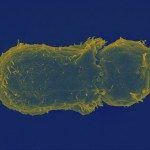Link to Pubmed [PMID] – 2562953
J. Biol. Chem. 1989 Jan;264(2):1068-76
Stimulation of human T-lymphocytes via either the surface T3-Ti antigen-major histocompatibility complex receptor complex or the T11 molecule results in clonal proliferation through a calcium-dependent mechanism. To investigate this signal transduction, plasma membrane calcium-permeable channels were characterized in T-lymphocytes by means of whole cell or single channel patch-clamp recordings. Stimulation of T-lymphocytes via either structure results in opening of an identical set of voltage-insensitive plasma membrane Ca2+-permeable channels through the action of a diffusible second messenger. Previous work with excised inside-out patches suggests that inositol 1,4,5-trisphosphate is the activating second messenger of the voltage-insensitive T-cell Ca2+-permeable channel. Since there is a significant increase in phosphoinositide turnover after stimulation via either the T3-Ti or T11 pathway, it is suggested that triggering of either structure opens a common set of channels through this mechanism. Furthermore, currents flowing through Ca2+-permeable channels are apparently autoregulated, as inward conductance is abolished by elevation of Ca2+ concentration in the bathing solution. In particular, the steady-state rise in interleukin-2 (T-cell growth factor) mRNA is dependent on the rise of [Ca2+]i resulting from ion movement across this channel.

